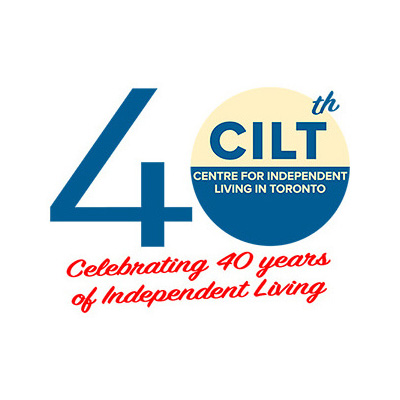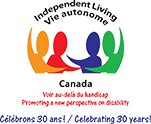Independent Living in Canada: An Overview
– by Victor R. Willi, past Executive Director (with minor updates by Sandra Carpenter, past Executive Director)
The Independent Living (IL) Movement, as we know it today, began with the establishment of a consumer-controlled, self-help centre in 1972.The Berkeley Centre for Independent Living was started by a group of students with disabilities at the University of California. This IL Movement, with its philosophy, principles, and attitude was introduced into Canada by Gerben DeJong at the COPOH National Conference – “Parameters of Rehabilitation” in Vancouver in 1980. The main focus of this article will be how the IL Philosophy is manifested in the Independent Living Resource Centres (ILRCs). I offer two caveats: first, it is difficult, if not impossible, to understand Independent Living separately from its historical and social context (Dejong, 1980)ii; second, Independent Living is almost universally misunderstood.
According to Woodill (1992), “The phrase ‘Independent Living’ has been part of social service discourse since the end of World War II… because of its long history in the professional literature, as well as its use by recipients of professional services, there are several meanings to the term…” iii In Ontario, for example, it is common to be told that Independent Living refers to one of two things: a person in a wheelchair, living alone in an accessible apartment; or, some sort of technical device such as a walker or bath bench. In addition, the term has been associated with accessible housing, transitional living centres, hospital units, the study of home economics, rehabilitation programs and so on. In reality, the term, ‘Independent Living’ actually refers to a flourishing but little known social movement.
Key Features of Independent Living
The original philosophy developed by a handful of persons with a disability at Berkeley had three guiding principles that were grounded in the common sense reality of day-to-day experiences:
- Those who know best the needs of disabled people and how to meet those needs are the disabled people themselves;
- The needs can be met most effectively by programs which provide a variety of services, rather than having to go to several different agencies for services;
- Disabled people should be as integrated as possible into the community.
Unlike the fragmented services offered by conventional service providers, the Physically Disabled Students Program took:
[a] holistic, integrated approach by providing a comprehensive array of services in recognition of the fact that disabled people are likely to have a variety of needs, and functional independence will be hard to achieve unless all those needs are met. Self-evident though this may seem in hindsight, such an approach had, to our knowledge, never been tried before… The fact that the idea for a services program, on one hand, came about largely for expedient reasons (namely, the exigencies of funding) and, on the other hand, was a logical outgrowth of the students’ past experience might lead one to overlook its enormous significance for disabled people….(Zukas, 1979)
In summary, the Independent Living movement evolved as a social movement or struggle for civil liberties by persons with a disability using self-help tactics. The idea of one disabled person helping another was revolutionary since it is not unusual, even today, for persons with a disability to avoid each other. Independent Living is really about interdependence, not living in isolation.
What is Independent Living in Canada?
The Independent Living Philosophy in Canada has evolved differently than in the United States. According to IL Canada’s ELIGIBILITY CRITERIA FOR IL CANADA MEMBERSHIP (ECCM) v, the key elements of ‘Independent Living’ have a dual purpose. For the individual, IL is an attitude; for an ILRC, it is a set of organizational principles as well as a set of program methods and resources.
The individual is called upon to examine choices, make decisions, take risks, and generally take responsibility for his or her life. This is facilitated by the ILRC. The ILRC is about empowerment, with a mandate to promote the “progressive process of citizens with disabilities taking responsibility for the development and the management of personal and community resources.” (IL Canada, 1990)
An ILRC must use a consumer-controlled, community-based, cross-disability approach as a basis for operation. For example, in a typical ILRC, the Board of Directors, the Executive Director and the core staff consist mostly of persons with disabilities. The Board of Directors must, by law, be fifty-one per cent disabled persons.
Furthermore, the core programs fundamental to every ILRC are Information and Referral, Peer Support, Individual Advocacy/Skills Development and development of new forms of service delivery (research and development). As a method for carrying out the mandate, the core programs reflect the organizational principles.
At its most fundamental level, an Independent Living Resource Centre is a place where individuals with a disability can learn to control their own life. They can become aware of their options, make choices, and take risks all with the support of someone else who has been there before them. A Centre is a place where persons with a disability can help each other.
On a final note, Independent Living Canada consists of 26 thriving Independent Living Resource Centres across Canada, from Newfoundland-Labrador to Vancouver Island, with are 12 ILRCs right here in Ontario.
The national body located in Ottawa, has a Board of Directors made up of Executive Directors from local centres.
Currently 33 persons work at CILT and there are 12 persons on our board of directors, 16 of these with disabilities.
i. Published in Research Network for Social Participation RNSP Network Bulletin Vol 1 No 4, Dec 1995, pp 2-3.
ii. DeJong, Gerben. “Rehabilitation and the Challenge of Independent Living”, speech given at COPOH’s meetings May 3, 1980 in Vancouver, British Columbia.
iii. Woodill, Gary. Independent Living & Participation in Research: A Critical Analysis (Toronto: Centre for Independent Living in Toronto (CILT) Inc., 1992), p. 24.
iv. Zukas, Hale.”CIL History” (Berkeley: Centre for Independent Living, Inc., 1979).
v. Canadian Association of Independent Living Centres, ELIGIBILITY CRITERIA FOR IL Canada MEMBERSHIP (ECCM) (Ottawa: IL Canada, 1990), p. 2.







